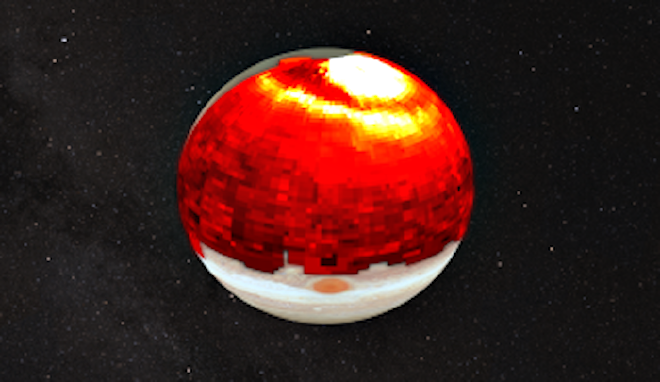

Scientists at the University of Reading have discovered a solar wind event from 2017 that hit Jupiter and compressed its magnetosphere – a protective bubble created by a planet’s magnetic field. This created a hot region spanning half Jupiter’s circumference and exhibiting temperatures exceeding 500°C – significantly higher than the typical 350°C atmospheric background temperature.
A new study published in Geophysical Research Letters, describes for the first time a solar burst that scientists now believe hits Jupiter 2-3 times a month.
Dr James O’Donoghue, lead author of the research at the University of Reading, said: “We have never captured Jupiter’s response to solar wind before – and the way it changed the planet’s atmosphere was very unexpected. This is the first time we’ve ever seen a thing like this on any outer world.
“The solar wind squished Jupiter’s magnetic shield like a giant squash ball. This created a super-hot region that spans half the planet. Jupiter’s diameter is 11 times larger than Earth’s, meaning this heated region is enormous.
“We’ve studied Jupiter, Saturn and Uranus in increasing detail over the past decade. These giant planets are not as resistant to the Sun’s influence as we thought – they’re vulnerable, like Earth. Jupiter acts like a laboratory, allowing us to study how the Sun affects planets in general. By watching what happens there, we can better predict and understand the effects of solar storms which might disrupt GPS, communications, and power grids on Earth."
Different impacts for big planets #
By combining ground-based observations from the Keck telescope with data from NASA’s Juno spacecraft and solar wind modelling, the researchers determined that a dense region of solar wind had compressed Jupiter’s enormous magnetosphere shortly before the observations began. This compression appears to have intensified auroral heating at Jupiter’s poles, causing the upper atmosphere to expand and spill hot gas toward the equator.
Scientists had previously thought Jupiter’s rapid rotation would confine auroral heating to its polar regions through strong winds. This discovery shows otherwise, suggesting planetary atmospheres throughout our solar system may be more vulnerable to solar influences than previously understood. Solar bursts could significantly alter big planets’ upper atmospheric dynamics, generating global winds that drive energy distribution across the planet.
Professor Mathew Owens, a co-author from the University of Reading, said: “Our solar wind model correctly predicted when Jupiter’s atmosphere would be disturbed. This helps us further understand the accuracy of our forecasting systems, which is essential for protecting Earth from dangerous space weather.”
Citation #
O’Donoghue, J., Moore, L., Melin, H., Stallard, T., Kurth, W. S., Owens, M., Bhakyapaibul, T., Tao, C., P. Connerney, J. E., Knowles, K. L., Kita, H., Roberts, K., Tiranti, P. I., Agiwal, O., Johnson, R., Wang, R., Thomas, E., & Murakami, G. (2025). Sub-Auroral Heating at Jupiter Following a Solar Wind Compression. Geophysical Research Letters, 52(7), e2024GL113751. https://doi.org/10.1029/2024GL113751
- The article Solar wave squeezed Jupiter’s bubble to unleash heat was published in University of Reading’s news section.

